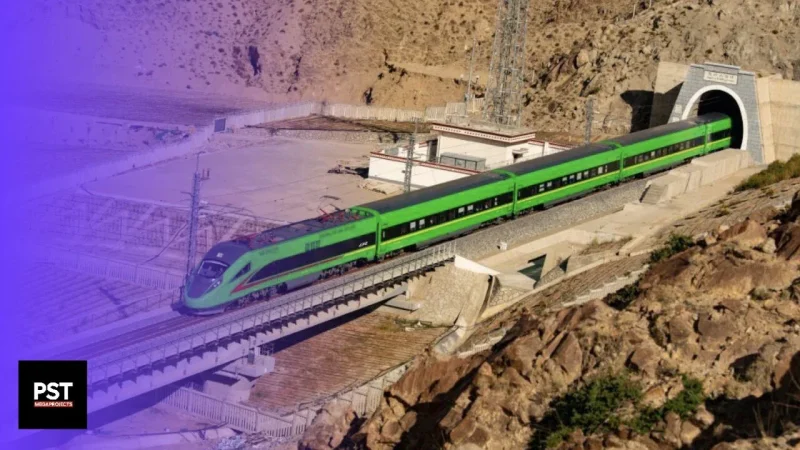China is once again pushing the boundaries of modern engineering. The country is building a railway tunnel that stretches across a staggering distance of approximately 30 kilometers, piercing through the very heart of the world’s highest mountain range, the Himalayas.
This railway will connect China’s autonomous Tibet province with Nepal’s capital, Kathmandu, enhancing connectivity and economic development between the two countries.
But, as you’d expect, a megaproject of this size is bound to face countless challenges before it becomes a reality, from the unforgiving mountainous terrain of the Himalayas, to the treacherous weather conditions that can make construction an impossible task.
The Origins of the Project
Back in August of 2022, the Nepalese foreign minister, Narayan Khadka, visited China and expressed Nepal’s aspiration to establish a comprehensive and interconnected transportation network across the Himalayan landscape with China.
In response, China pulled up the blueprints for the China-Nepal railway. The concept of establishing a route between the two countries actually dates back to four decades ago. In fact, it was first proposed by China’s Mao Zedong, but the implementation of the project was delayed over the years.
This was thanks to various reasons, such as the financial and technical challenges faced by both China and Nepal in the past, which made the construction of a highly complex railway across the Himalayas a pipe dream.
But now, China’s infrastructure technologies and capabilities have evolved exceptionally, and the idea was revived in 2022, a year that saw China investing around $4.3 billion to start the construction of the China-Nepal railway.
Benefits to Nepal
The railway is expected to cost a total $5.4 billion, which the two countries will raise by the issuance of bonds. This cost averages around $46 million per kilometer. When compared with the cost of the world’s longest railway tunnel, the Gotthard Tunnel, which stood at $198 million per kilometer, the cost efficiency of China’s initiative becomes crystal clear.
This railway would greatly help Nepal, as it’s a landlocked country that can only economically function by having uninterrupted access to sea ports on the East and South China Seas. In addition to that, Nepal has been struggling with transportation issues for a really long time. This is because the country’s mountainous terrain hinders travel locally, which in turn restricts the nation’s economic and trade development.
Once completed, this railway will connect three major cities in Nepal, easing commuting between them, and offering Nepalese citizens a new method of transportation that isn’t expensive flights or long car drives.
Increased Connectivity
The railway project has two sections, one in China and one in Nepal, and the Chinese section is located across Tibet, which neighbors Nepal. The two are famous for beautiful scenery, rich history, and friendly people, and all of that strengthens their tourism industries.
In fact, during the first half of 2023, Tibet received more than 24 million tourist visits, and in comparison, Nepal saw 4.7 million tourists for the same period. Therefore, a direct connection between these two popular tourist hubs would definitely give a massive boost to Nepal’s tourism industry.
This new railway project is an extension to the Rigi Railway, a branch of China’s Qinghai Tibet Railway, into Nepal. According to the plans, the total length of the China-Nepal railway is about 540 kilometers, or 335 miles.
The construction is expected to be completed sometime around 2033. But, there are various challenges facing China and Nepal in their quest to make this project a reality.
The Challenges
What makes this project so challenging is mostly the fact that it’s being built across the Himalayan region, which encompasses seismic zones and icy glaciers. There are also the constant mudslides, which could put construction workers and equipment in grave danger.
These challenges highlight the necessity of deploying cutting-edge technologies in the construction in order to maintain construction quality, as well as safety standards. For example, a big challenge that China faces is the construction of the Himalayas Tunnel, a massive tunnel through the Himalayan mountains that the trains are supposed to pass through.
China initiated the construction of the tunnel in February of 2023, and after five months, the tunnel project achieved an excavation progress of 1,680 meters. This is extremely fast and efficient progress, but it’s also just the tip of the iceberg. In fact, the comprehensive length of this tunnel is planned to span approximately 30 kilometers.
The cold region, as well as the high altitude, introduced a significant obstacle to engineers and construction workers building the tunnel. Additionally, as you might already know, the higher you go above sea level, the less oxygen you get. Therefore, the deficiency of oxygen in the Himalayas quickly became a concern.
In order to solve this problem, the team working on the Himalayas Tunnel has turned to using specialized generators to ensure the constant supply of oxygen to construction workers.
In addition to that, China deployed the Jinghua Shield Machine to speed up the efficiency of the construction. This massive machine boasts a large diameter of 16.07 meters and an impressive mass of 4,300 tons, which allows it to excavate a tunnel equivalent in height to a six-storey building in a single path.
It employs forward-cutting blades to cleave through layers of soil, and easily disposes of the excavated dirt and removes it out of the tunnel and away from the site through a conveyor belt mechanism.
Can China Pull it Off?
China will definitely ace this project as it previously accomplished a similar feat. For example, China successfully completed the Lhasa-Nyingchi high-speed railway, which cost around $5.6 billion and involved advanced engineering to overcome harsh weather conditions.
In fact, 90% of its route sits at altitudes higher than 3,000 meters above sea levels, as it moves through mountain tunnels, bridges, and archways. It now features 47 tunnels and 121 bridges, which make up 75% of the entire route.
It’s also important to note that China is intent on completing this railway because it’s part of a much larger megaproject called the Trans-Himalayan Multi-dimensional Connectivity Network, which is an economic corridor between China and Nepal that the two countries agreed to build after Nepal joined the Belt and Road Initiative in 2017.
This megaproject consists of several transportation infrastructure projects, with the China-Nepal railway being the flagship project. In fact, it includes a number of highway projects in Nepal, including the construction of a tunnel road, and upgrading the Araniko Highway, which was shut down after the Gorka earthquake in 2015.
Most of the projects in the Trans-Himalayan Multi-dimensional Connectivity Network are completed or approaching completion, while the railway project was delayed thanks to the Covid-19 pandemic and recent changes to the plans after new feasibility studies were conducted.
According to these studies, as much as 98% of the Nepalese section of the railway will be in bridges or tunnels to accommodate for the mountainous terrain. There will be four stations along the line, with the terminal at Sankhu in Kathmandu, and a further extension to Pukhara and Lumbini is planned for the future.
A Dig at India?
Even though Nepal enjoys friendly relations with China, and signed multiple agreements with it on trade and transit that allowed the use of Chinese ports for Nepal’s trade with other countries, there might be another underlying reason why China is building this railway.
Many think that building this railway is a strategic move by China meant to undermine India’s influence on Nepal, which increased significantly throughout the 1950s, giving Indians the right to immigrate to Nepal and acquire Nepalese citizenship without any difficulty, and allowing India to place economic sanctions and blockades on Nepal during times of disagreements between the two countries.
In fact, when Chairman Mao Zedong first proposed the idea of a link between China and Nepal, he said that Nepal wouldn’t need to worry about India once it’s completed. This led many to ask, is the revival of the initiative China’s way of fulfilling this promise?
This could definitely be the case, as the imposing presence of the Himalayan mountains has for long isolated China from the Indian subcontinent, but with the completion of the China-Nepal railway, connectivity between China and the region will increase.
The Chinese side of the project is even hoping to establish a direct link between the China-Nepal railway and the Indian railway network, which will further facilitate trade and ties between the two Asian giants.
This might be the only way to appease India, because otherwise, this megaproject threatens India’s goal of dominating the entirety of South Asia, and it has in fact tried to obstruct the construction of the railway by cutting off water, electricity, and oil supplies to Nepal.
Once the railway is built, it will be impossible for India to “cut off” supplies to Nepal, and India’s control over Nepal will be greatly reduced. In other words, by befriending China and having access to it through the Himalayas, Nepal will be able to break India’s dominance in its foreign trade and gain more economic initiative.
For now, we have to wait and see how China and Nepal will navigate this, as appeasing India could be just as challenging as drilling through the Himalayas. Still, this project is expected to allow Nepal’s economy to grow 10 times faster, so we can’t help but wish it gets completed to help its country.
Disclaimer
Please visit and read our disclaimer here.









